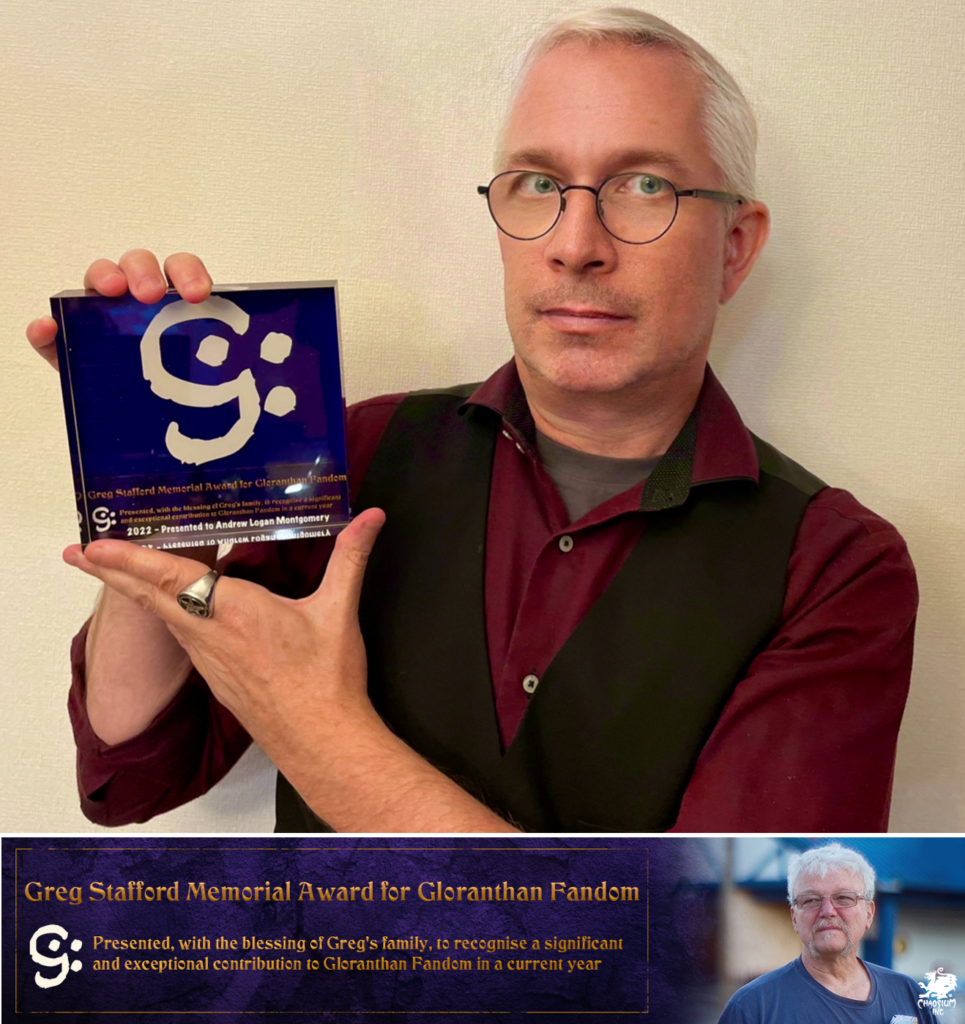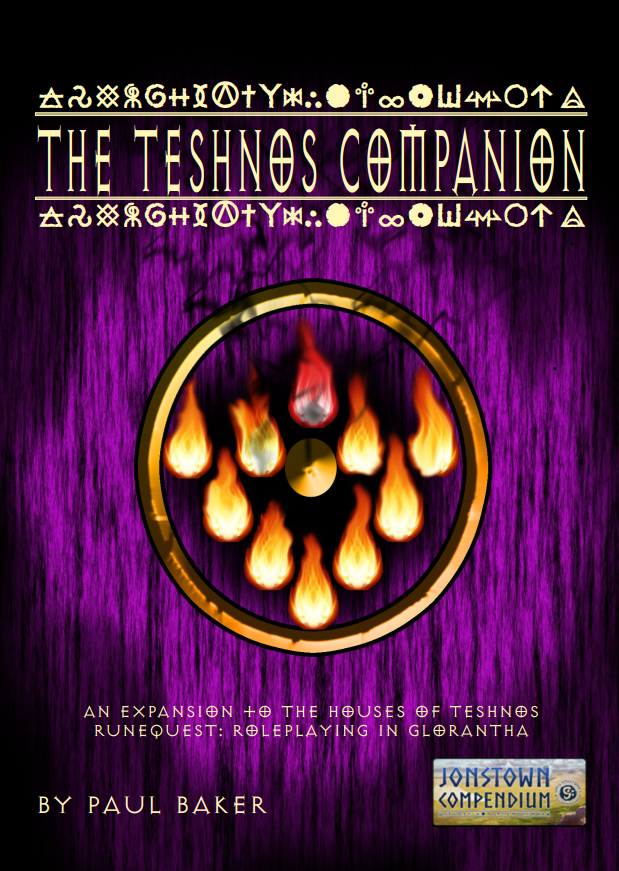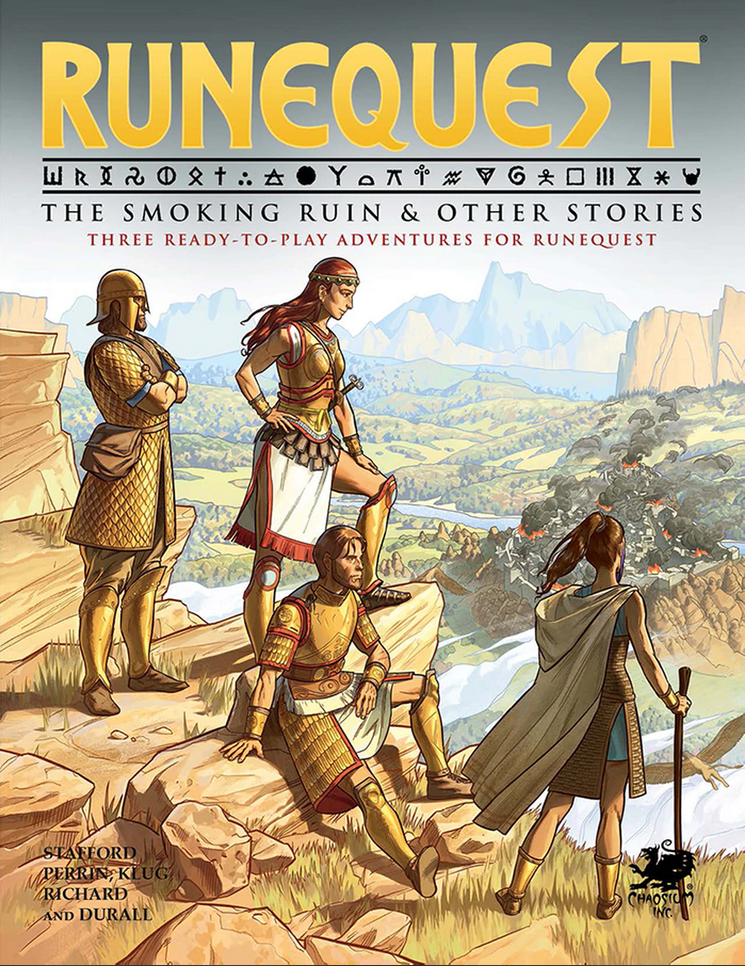Welcome to a new issue of the Journal of Runic Studies, the premier Malkioni publication for studies into the nature of Glorantha. If you haven’t subscribed yet, please consult with the spirit bound to the appropriate electronic page.
This week is rather expedited in terms of the newsletter. I have been busy with work, family life, and writing & illustration, and a few other hobbies… so that left little time for the Journal. Oh well. And if you want to help, remember that you can always send us a guest segment!
Chaosium News

Here are this week’s Chaosium news!
The 2022 Greg Stafford Memorial Award for Gloranthan Fandom goes to Andrew Logan Montgomery

Surprising absolutely nobody, I think, Andrew Logan Montgomery finally got the Greg Stafford Memorial Award for Gloranthan Fandom! Congrats and well deserved, Andrew!
This award is given every year since the passing of Greg Stafford to celebrate a notable member of the Gloranthan community. Andrew definitely qualifies, with no less than three best-selling RuneQuest campaigns on the Jonstown Compendium, and many insightful articles on his blog. You can read more here, including the past award recipients.
Assembling the Stafford Campaign Notes

Last week Chaosium released the Stafford Campaign in PDF and print-on-demand: a collection of essays and notes from Greg Stafford, some of which had been published in APAs such as The Wild Hunt in the mid-1970s. Rick Meints also posted another “Out of the Suitcase” entry on the Chaosium blog about the occasion:
What most people may not know is that many of these “articles” were published back in the day while the campaign was active. That stems from the fact they were published in a relatively obscure and very difficult to get a hold of fanzine called The Wild Hunt. About 200 copies of each issue were printed using mimeograph machine technology. Articles were often typed on typewriters using stencils. After 40 years, many of the original issues have not survived the ravages of time, especially as they were printed on inexpensive paper. I doubt even half of the copies printed still exist. I’ve been tracking them down and pursuing them for over 30 years and my personal set of The Wild Hunt is far from complete.
Note that the first two chapters of this newly released “Chaosium Archival Collection” are available to read for free here. If you’re sold on it, it’s available in softcover and PDF.
Fantasy Grounds Update
You might remember that official VTT support for RuneQuest is underway for Fantasy Grounds (among possible others), as we had a few updates here and there in the newsletter. Here are some latest screenshots… it sounds like it’s almost ready for release.

If you look closely, you’ll see an “Opposed & Resistance Rolls” dialog for, well, making opposed and resistance rolls. The resistance roll comes out like this in the chat:

There’s no official release date or pricing info yet but the latest status updates from the developer made it sound like it was down to the last few known bugs and some polish… fingers crossed!
Jonstown Compendium

The Jonstown Compendium is Chaosium’s community content program for all Gloranthan games, hosted on DriveThruRPG. Disclaimer: all the relevant links are affiliate links that hopefully will let us cover some of the hosting and maintenance costs for the website and podcast! Thanks for using them!
Teshnos Companion

Paul Baker has released a companion book to his Houses of Teshnos, with further explorations of this seldom covered area of Glorantha.
Jeff’s Notes

Jeff Richard, the current mastermind on everything Gloranthan at Chaosium, is often posting notes and thoughts on the RuneQuest Facebook group. Here’s our curated list from the past week. A partial archive of these sources is compiled on the Well of Daliath.
Followers of the Prince of Sartar
Jeff describes what the royal Sartarite entourage looks like: the Prince’s household, the High Council, the Wolfbrother Guard, lots of scribes, artisans and artists leading royal projects… but most importantly, each Prince has a group of “companions”:
The Prince is always escorted by friends and companions, who accompany them at court and in battle. They hunt, feast, and drink with the Prince, serving as personal attendants and bodyguards. During the long rule of the Sartar dynasty, leading members of the tribes competed to serve as friends and companions of the Prince. Many of these friends and companions went on to become tribal kings, temple high priests, or the leaders of cities.
Player characters could belong to any of those groups but this latter one is probably the easiest way to have an eclectic bunch of adventurers be brought into royal circles… and benefit from it. It can even be a way to get in trouble:
And that’s the other nebulous thing – what role is actually being invoked? When the Prince speaks, well everyone knows that is with semi-divine authority. But when one of the Prince’s drinking buddies speak, what does that mean?
Dragon Pass Logistics
Jeff continues to run us through the various spreadsheets he has for central Genertelan states. This lets us look at Sartarite, Lunar, and Esrolian affairs from an economic and materialist point of view.
This note summarizes why Jeff goes to all this trouble to model population and cult distributions, finances, trade routes, and more. I know that some people sigh when they see number crunching like this but I find it a useful tool for world-building, so I totally agree with Jeff when, for instance, he says this in a subsequent note:
And again, none of this is necessary to run a RQ campaign or even write scenarios. BUT it helps me understand some of the pressures and changes going on in Sartar, that can be the source of scenarios and campaigns.
Lunar Empire
The second note on Lunar Imperial Finances follows from last week, still using “talents” to make numbers shorters (a “talent” is 300 Lunars). We get a rough breakdown of the imperial revenue, split between agricultural taxes, tolls and trade taxes, and other miscellaneous revenue streams. I’m surprised to not see Lunar cult tithes here: I would have expected Lunar temples from all around the empire to contribute financially to the state….?
Anyway, Jeff continues to illustrate the problems of the Lunar Empire through numbers and it doesn’t look good. Although it does look good for any campaign in Lunar provinces:
I expect what we will see is a combination of things. Some debasement (but not so much as to risk the veteran soldiers getting pissed). Looting of Lunar temples (“I am the son of the Red Goddess, and this stuff is mine anyways”). Confiscations, revocations of privileges and exemptions, etc.
[…]
I imagine that there are thousands of Irrippi Ontor cultists redoing assessments, looking up old rights, and doing the equivalent of looking for loose change under the mattresses. Every talent matters!
There’s a bunch of adventures to be had following one of those Lunar scribes going around some province to take back gifts, “negotiate” increased taxes with local chieftains, inventorize old cellars, loot ancient Dara Happan burial sites, and more…
The change of vibe for the Lunar Empire is also notable:
For decades, we were presented with a Lunar Empire of infinite resources, both financial and military. Rebellion was impossible because the Lunars could just throw money and troops at the problem.
But if we look more carefully, what we find is that the Lunar Empire has a lot of resources, but they have limits. And seven years of war, combined with conspicuous spending has made that worse.
This helps explain, at least to me, why the Empire could not easily reconquer Dragon Pass after the Dragonrise – and why Sartar got several years of breathing space after the Battle of the Queens.
Esrolia
The Royal Economy of Esrolia shows us how things changes in that corner of the (now former) Holy Country. The revenue streams for the Esrolian Queen are similar to those of the Lunar Empire, although I’m happy to see “temple contributions” mentioned here. I don’t know if it was an oversight for the Lunar finances, or if Lunar temples are indeed more financially independent… either way, one big difference in Esrolia is off course the big role that Nochet’s maritime trade brings to the table.
One thing I didn’t expect was that the Esrolian Queen in Nochet doesn’t necessarily sit at the top. Other city states like Rhigos are very important:
All of this revenue was collected at a “provincial” or “queendom” level and then the queens (advised by the Asrelia priestesses), allocated it among themselves. About half ended up at Nochet, a little over a quarter at Rhigos, and the rest split between the North March and Longsi Land. In the event of a dispute, they appealed to Belintar, who always wisely resolved the issue, sometimes paying out the City of Wonders vast treasuries.
Some notes here:
- Rhigos is just a couple dozen kilometres south of Nochet, as you can see on the map below. As far as I can tell it’s one of the rare city states of central Genertela. The city queen is the High Priestess of Delaina, the city’s patron deity and one of Ernalda’s sisters. You might have heard about the current queen, the “Demivierge of Rhigos“.
- The North March is the area around Valadon, north of Nochet. I’m not sure why they get their own revenue but I going to assume it’s got something to do with the Argan Argar cult and the Shadow Plateau next door.
- Longsi Land is the area between (and including) Belernos and Kosh, in the top-left corner of the map. It probably gained some sort of political and economic independence from the overall Esrolian Kingdom when they helped against the Hendriki during Aranda’s War in the mid 1100s. The city of Kosh was actually part of that deal.

Unlike the empire or Sartar, much of this was paid in kind. The agricultural tax in Esrolia is paid in kind, with wheat, barley, fruits, salted pork, whatever. This is brought to the Asrelia temples (which are big storehouses and granaries), to be released upon demand from the queen – for support of the priestesses, her household, payment to followers, distribution against famine, etc. Scribes and grandmothers oversee all of this, and everyone is kept plenty busy.
There is a lot of other good stuff in this note: what Belintar’s disappearance means for the Holy Country and Esrolia in particular, Esrolia’s problems with the Ditali and Solanthi raids of the late 1610s, the alliance with Argrath and Harrek in return for the plunder rights of the City of Wonders, the difference between an Esrolian court and a Sartarite court, the cost of maintaining a trireme army, and more!
Note that, in this note, Jeff states that the Queen of Rhigos is paying the warlords of Porthomeka (the region immediately to the south of Rhigos) with her riches. I wasn’t clear about this relationship from the short write-up found in the Guide. Maybe that will help someone else clarify this too.
Sartar
Feeding Boldhome goes over the logistics of agricultural production around the Sartarite capital. If you ever wondered where the grain silos are, and how big they are, now you’ll know.
Sartar’s Roads explains why the vast majority of trade crosses Dragon Pass through Sartar instead of the Grazelands. Of course, it has to do with those nice roads that Sartar built… and it doesn’t help that the Grazelanders run a protection racket.
Sartar Money and War is interesting because it looks at the logistics of the armies serving the Red Emperor, Kallyr Starbrow, and Argrath. The rationale about Argrath’s nomadic army being easier (at first) to feed and pay is particularly notable and might help you better place, foreshadow, and portray Argrath’s faction in your campaign.
Kallyr’s Lightbringers Quest
This note goes quickly over how Kallyr’s “stationary” Lightbringers Quest in 1626 is done as a “conventional” (dare I say “boring”?) heroquest:
Kallyrs Stationary Lightbringer Quest was much like how many people understand heroquesting. She got the tribes and temples to perform a giant ceremony filled with pageantry. People wore masks and sacred regalia and tried to carry out their sacred tasks as Kallyr and her companions moved around Sartar performing their reenactment of the Lightbringers Quest myth.
Spirits and people were summoned from outside. Yelmalion cultists showed up as did trolls and some elves. Others made sure the dragonewts did not enter. Monsters appeared and weird foreigners arrived. Broo and zombies both tried to exploit opportunities.
This is definitely an event that you want your players to participate in, whether they are doing some summoning on the sidelines, dealing with intruders, going along as part of Kallyr’s entourage, or maybe even taking advantage of the whole thing and riding on the massive amounts of magical energy for their own ends… this is what I assume most of the intruders are doing, actually. Spirits and monsters might show up knowing full well that the ceremony will be well defended, but the temptation of an easy gateway to the Hero Plane and its mythical riches might be too strong.
Of course, there’s also the possibility that these spirits and monsters have been simply “magically summoned” by the ritual, but frankly this sort of cheap narrative loophole is something I’ve grown to dislike about Glorantha. “The Broos are here because the myth had Chaos monsters in it, so of course they show up“… blech. Nope. Not in my Glorantha, thank you.
Gloranthan Terms
A lot of older Gloranthan material used terms with specific connotations, especially in the HeroWars/HeroQuest books. Terms like fyrd, cottar, moot, and so on summoned images of celts and vikings that wasn’t necessarily intended, and Jeff puts the blame on Greg being split between Glorantha and Pendragon. The most egregious terms that Jeff doesn’t mention here are probably the infamous “knights” of western Genertela, and all the Sartarite NPC names using the scandinavian “-sson” and “-dottir” suffixes.
With the revival of RQ, pretty much all of that has been swept away. About the only one we’ve kept is “thane” – which literally just means “retainer, attendant, companion,” which we could also transliterate as “Lord” or “Sir,” if we felt so inclined.
That’s good as far as I’m concerned. And the reason is sound:
Our mental visualization of Glorantha is shaped by the words we use to describe it. A big reason to get rid of those terms is to break the assumption that the Orlanthi are Germanic Northern Europeans. They aren’t. Those cultural elements they share with the ancient Germanics they share with plenty of other cultures – Thracians, Mycenaeans, Hallstatt Celts, Macedonians, Gandharans, Pashtuns, Mesoamericans, early Indo-Europeans, etc. “Militia” works just as well as “fyrd” and lacks the other connotations of the latter. It is also a lot easier to translate into other languages!
The Fourth Age of Glorantha
Jeff talks about the Fourth Age of Glorantha, the age that supposedly comes after the Hero Wars and its apocalyptic end (whatever it is). This is also the time from which the “unreliable narrator” of King of Sartar writes, so Jeff gives us some info and context to digest that.
Community Roundup
The community roundup is our highlight of interesting things being mentioned in the Glorantha-related Facebook groups, sub-Reddits, and other similar online places.
Bud Explains Illumination
Bud, from Bud’s RPG Reviews, has a series of short (but packed!) videos explaining various aspects of Glorantha. This latest video is about Illumination and you might have to pay attention because it’s a heavy one! But it’s very well presented and edited so you will enjoy watching it a couple times to unpack it all.
SkullDixon on Running Battle Scenes

SkullDixon (which we interviewed in our initiation series) has a blog article about running a big battle scene in RuneQuest! He writes it from the perspective of running Urvantan’s Tower (from The Smoking Ruin & Other Stories), so watch out for spoilers on that adventure.
In the Battle of Trueford section, it reads, “If desired, rather than delve into a round-by-round battle where every single combatant is tracked. The gamemaster is encouraged to make this fray more visceral than specific, using narrative description where possible to keep the pressure and intensity driving, and breaking combat into short, brief, and brutal encounters.”
[…]
Unfortunately, the adventure doesn’t give much advice on “make this fray more visceral than specific, using narrative description where possible.” So that’s what I hope to do with this post. Give some guidance on how to set up the battle for your game to make it easy to run and enjoyable from a gameplay perspective while still being more thematic than a slog full of moving pieces.
Get your practical advice here!
Thank you for reading
That’s it for this week! Please contact us with any feedback, question, or news item we’ve missed!


